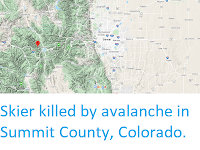An avalanche has killed two snowshoers and their dog in Summit County, Colorado, according to the Colorado Avalanche Information Center. The incident happened on a flank of North Star Mountain on Saturday 8 January 2022, and was discovered by volunteers from the Summit County Rescue Group and Flight for Life, who began searching the area after the couple failed to return. They discovered an avalanche track 400 m wide and about 250 m long, where the bodies of all three victims were found buried by a rescue dog. The dead snowshoers have been identified as Hannah Nash, 25, and Drake Oversen, 35, both of Colorado Springs. This is the second fatal avalanche in Colorado this winter.
Avalanches are caused by the mechanical failure of snowpacks; essentially when the weight of the snow above a certain point exceeds the carrying capacity of the snow at that point to support its weight. This can happen for two reasons, because more snow falls upslope, causing the weight to rise, or because snow begins to melt downslope, causing the carrying capacity to fall. Avalanches may also be triggered by other events, such as Earthquakes or rockfalls. Contrary to what is often seen in films and on television, avalanches are not usually triggered by loud noises. Because snow forms layers, with each layer typically occurring due to a different snowfall, and having different physical properties, multiple avalanches can occur at the same spot, with the failure of a weaker layer losing to the loss of the snow above it, but other layers below left in place - to potentially fail later.
See also...



Follow Sciency Thoughts on Facebook.
Follow Sciency Thoughts on Twitter.





